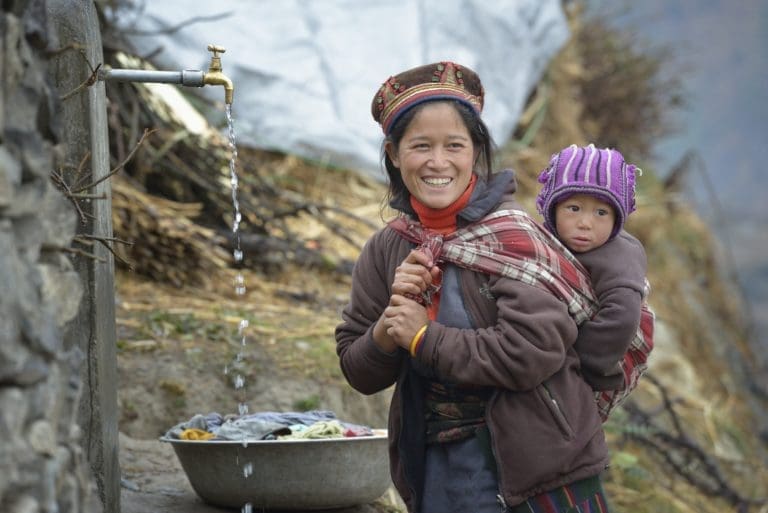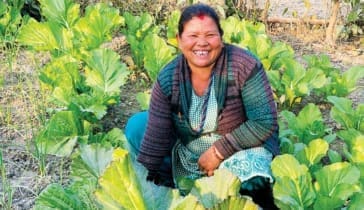published in Earthquake • Natural Disaster on April 4, 2018
Nepal Earthquake – three years on
It was ANZAC Day 2015 when a shattering 7.8 magnitude earthquake hit Nepal. The disaster killed nearly 9,000 people, injured 22,000 more people, and destroyed 750,000 houses.

Within hours, the LWF (Lutheran World Federation) team our ALWS family supports in Nepal were delivering aid.
The response from the ALWS family was also immediate, and generous.
Together, working alongside churches of many denominations from around the world through ACT Alliance, emergency aid was delivered where it was needed most:
• Emergency shelter kits for 18,447 families
• Transitional shelters for 7,552 families
• 5,272 families supported to build toilets
• 18,447 families receive beds, bedding and kitchen utensils
• 10,592 hygiene kits distributed (toothbrush, toothpaste, bath soap, laundry soap, women’s underwear, sanitary napkins, bucket, mug)
• Repair / renovate / construct 66 village water schemes
• 1,291 Community-Based Psychosocial volunteers identified and trained …
• … who then give support to 4,793 adults and children
• 4,622 vulnerable families receive ready-to-eat food packets of rice, noodles and biscuits
• 6,353 families receive basic 30-day food ration of rice, lentils, vegetable oil, salt, sugar and fortified food
• 6,776 families receive cash support to resume family livelihoods
Of course, rebuilding after a disaster on this scale takes much longer.
Dr Prabin Manandhar, who headed the emergency response for LWF, observed:
“Reconstruction is not only about rebuilding homes, but also about rebuilding our heritage.”
That’s why ALWS continues now to take your help to families in need in Nepal – both those still recovering after the earthquake, and those trapped in poverty for other reasons.
Pasang Tamang is the young mum of two children. Though four people died in her village, and nearly all the houses were destroyed, her family survived.
Pasang is desperate families like hers are not forgotten. Even a year after the earthquake, Pasang and her children were struggling to survive in a hut she built from corrugated iron sheets and wood she recycled from her damaged house.
Each year, families like hers fear the damage the monsoons can bring when the shelter is flimsy:
“I hope we will get support in rebuilding our houses the traditional way, so we can survive in this cold, remote place.”
Your ALWS family support means our LWF Nepal partners can train people (including many women) in masonry. This will ensure houses have a strong structure when using locally available materials like stones, mud and wood.
At the same time you continue to work with families building Long Drop Loos, improving farming skills to increase income, and supporting communities in seeking basic human rights.
Photo: ACT/P. Jeffrey

Categories
- Advocacy
- ALWS 70th & Bonegilla
- Animals
- Australian Government
- Awareness Day
- Child Protection
- Children
- Christmas Action
- Climate change
- Community Education
- COVID-19
- Disability
- Donors
- Earthquake
- Education
- Emergency
- Family
- Farmer
- Farming / Agriculture
- Flood
- Food Security
- Fundraising
- Gifts of Grace
- Health / Healthcare
- Hope Spots 2024
- Houses
- Human Rights
- Livelihoods / Small Business / New Skills
- Natural Disaster
- Poverty
- Refugees
- Social Justice
- Sustainable Development
- Take Action
- The GRACE Project
- Toilets / Sanitation
- Tsunami
- Village Partnership Program
- Walk My Way
- War / Conflict
- WASH
- Water
- What's My Business
- Women / Girls
- Worship / Chapel / Devotion
- Your Love At Work
Recent News & Stories
- Walk My Way Ukraine - Brisbane 2024
- Hope Spot 13 - Hope when it hurts
- Hope Spot 12 - No Parking
- Hope Spot 11 - What's Cooking?
Archives
- April 2024
- March 2024
- February 2024
- January 2024
- November 2023
- October 2023
- September 2023
- August 2023
- July 2023
- June 2023
- May 2023
- April 2023
- March 2023
- December 2022
- September 2022
- June 2022
- May 2022
- March 2022
- January 2022
- August 2021
- July 2021
- June 2021
- May 2021
- April 2021
- March 2021
- February 2021
- November 2020
- October 2020
- September 2020
- May 2020
- April 2020
- March 2020
- February 2020
- January 2020
- November 2019
- October 2019
- May 2019
- April 2019
- March 2019
- February 2019
- January 2019
- November 2018
- October 2018
- August 2018
- July 2018
- April 2018
- March 2018
- February 2018
- January 2018
- January 2016

Veggie Seeds $11
Cauliflower, cabbage, potatoes, tomatoes, onion, garlic, chilli, carrots and beans!
learn more